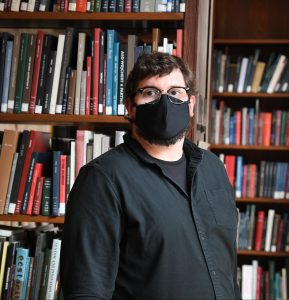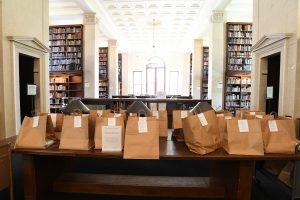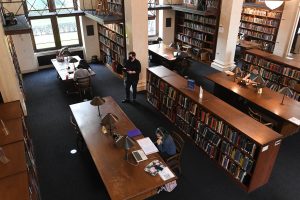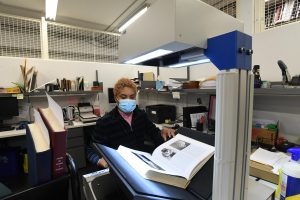
Q: What does your work at the Avery Architectural & Fine Arts Library entail on a daily basis, and how is it different from before?
With the help of an excellent team of five people, I oversee Access Services at Avery Library. Access Services encompasses a lot of the public services our users associate with the Libraries: checking books out, Scan & Deliver, reserves, interlibrary loan, shelving, helping users find books in our stacks, and general “customer service” regarding use of the libraries and their resources. I also assist in reference–both in person and via the Ask a Librarian chat service–although I’ve taken a break from those in recent months to focus on navigating all the changes in Access Services. A lot is different than it was in the beginning of the year: Avery now circulates part of its collection, we page all non-circulating books for users, we have a seat reservation system, and we scan more than ever before! We also work to protect the health and safety of library users and library staff alike, reworking our spaces and policies to be in keeping with the public health recommendations coming from the university, the city, and the state.
Q: You once likened Access Services to HVAC, in that no one considers what’s behind such a complex system until it stops working properly. What’s it been like to reopen spaces and services gradually after a complete shutdown last Spring?

I would love to take credit for that line, but I believe I first heard it from Damon Jaggars, a former Associate University Librarian here at Columbia and now University Librarian at Ohio State. That said, I’ve never heard my work more aptly described!
To be honest, most of the time, I don’t have to think too much about all the intricacies of the workflows and processes that make the Avery Access Services machine run smoothly on a daily basis, and that is a credit to the incredibly smart and hard-working people on our team. When we began introducing new services and re-introducing existing services upon reopening, however, we had to rethink every step of everything we do to retrofit it to the context in which we all now live. While stressful at times, this has been hands-down the most exciting time of my career because it afforded me an opportunity to really look under the hood. I think decisions made to adapt to the pandemic will inform how we provide Access Services to our patrons going forward, even after COVID-19 has passed.
Q: Have there been any major changes to how Columbia users can utilize Avery’s collections during the pandemic?
It might be easier to list what hasn’t changed! The biggest change, of course, is that we are circulating a significant portion of our onsite collection. For over a century, Avery Library has been a largely non-circulating library, but now most of the Avery-LC collection circulates via the Pick-Up service. The Avery-LC collection includes titles about architecture, art history, urban planning, archaeology, and all the other subjects Avery covers, and consists of titles acquired in the last decade, so our users can easily stay current with the latest research and writing in their fields.
Beyond circulating the Avery-LC collection, over 20% of Avery’s collections are available via HathiTrust’s Emergency Temporary Access Service. I have heard time

and again from our users that this access has been invaluable to their study, research, and scholarship. Our Scan & Deliver service, while not new, is another way in which our users can interact with our collections without having to come to campus and the numbers show that our users are availing themselves of it like never before.
Lastly, as a lot of our collection still must be used in our library, and with tremendous help from the Libraries’ indefatigable IT team, we created an On-Site Use paging function in CLIO so that users can request non-circulating items for use during seat reservations. I am perhaps a romantic–more likely a Luddite–but I am still very enamored of the physicality of books, especially art and architecture books. So many of the books in our collection are beautiful objets d’art in their own right. I’m glad that we can still provide physical access to these items for our faculty and students.
Q: What professional decisions or experiences led you to work in the Libraries?
I have long joked that I work in libraries because it sounded better than making pizza. When I was a freshman in college, I dragged my feet in looking for a work-study job and by the time I got to asking around the two positions I was offered were working in the interlibrary loan office, and making pizzas in a late night cafe on campus. It wasn’t a hard choice! Twenty years later, I am more enthusiastic about my work than ever before. (I still like pizza, though.)
I’m also a bit of a dilettante. Assisting others in their research has given me the opportunity to indulge my natural curiosity, with someone else’s research needs as a guide to focus my attention. Beyond that, maybe it’s my native Midwestern bonhomie, but I really enjoy helping people. I find it very rewarding

to help a library user find a piece of the puzzle that helps bring together a book, a dissertation, or even just a term paper.
Q: What’s been the biggest challenge – professionally or personally – about working in this new and sometimes trying reality of the pandemic? How do you stay positive?
Professionally, the sheer amount of change in how we’re doing things has been a challenge, but as I’ve noted above, it’s also proven to be an incredible opportunity to interrogate our services and processes. It’s easy to get locked into workflows because “that’s how we’ve always done it.” Now we have empirical proof that we can adapt, and do so quickly, without the sky falling. This is a powerful lesson I will take forward and it will inform how I see my work going forward. Personally, while returning to work in person has made me feel something closer to normal, I do miss my remote work officemates: my wife and 18 month-old daughter.
Throughout all of this, I have maintained positivity by compartmentalizing, making and editing to-do lists, ignoring said to-do lists when circumstances demand, and by drinking lots and lots of coffee.